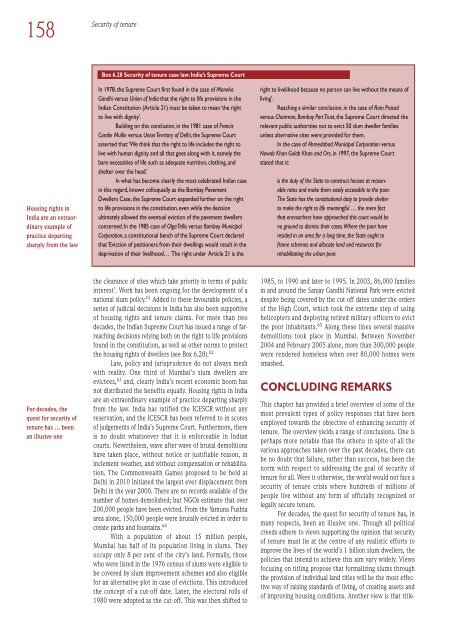Download the file - United Nations Rule of Law
Download the file - United Nations Rule of Law
Download the file - United Nations Rule of Law
- No tags were found...
Create successful ePaper yourself
Turn your PDF publications into a flip-book with our unique Google optimized e-Paper software.
158Security <strong>of</strong> tenureHousing rights inIndia are an extraordinaryexample <strong>of</strong>practice departingsharply from <strong>the</strong> lawBox 6.28 Security <strong>of</strong> tenure case law: India’s Supreme CourtIn 1978, <strong>the</strong> Supreme Court first found in <strong>the</strong> case <strong>of</strong> ManekaGandhi versus Union <strong>of</strong> India that <strong>the</strong> right to life provisions in <strong>the</strong>Indian Constitution (Article 21) must be taken to mean ‘<strong>the</strong> rightto live with dignity’.Building on this conclusion, in <strong>the</strong> 1981 case <strong>of</strong> FrancisCoralie Mullin versus Union Territory <strong>of</strong> Delhi, <strong>the</strong> Supreme Courtasserted that:‘We think that <strong>the</strong> right to life includes <strong>the</strong> right tolive with human dignity and all that goes along with it, namely <strong>the</strong>bare necessities <strong>of</strong> life such as adequate nutrition, clothing, andshelter over <strong>the</strong> head.’In what has become clearly <strong>the</strong> most celebrated Indian casein this regard, known colloquially as <strong>the</strong> Bombay PavementDwellers Case, <strong>the</strong> Supreme Court expanded fur<strong>the</strong>r on <strong>the</strong> rightto life provisions in <strong>the</strong> constitution, even while <strong>the</strong> decisionultimately allowed <strong>the</strong> eventual eviction <strong>of</strong> <strong>the</strong> pavement dwellersconcerned. In <strong>the</strong> 1985 case <strong>of</strong> Olga Tellis versus Bombay MunicipalCorporation, a constitutional bench <strong>of</strong> <strong>the</strong> Supreme Court declaredthat ‘Eviction <strong>of</strong> petitioners from <strong>the</strong>ir dwellings would result in <strong>the</strong>deprivation <strong>of</strong> <strong>the</strong>ir livelihood… The right under Article 21 is <strong>the</strong>right to livelihood because no person can live without <strong>the</strong> means <strong>of</strong>living’.Reaching a similar conclusion, in <strong>the</strong> case <strong>of</strong> Ram Prasadversus Chairman, Bombay Port Trust, <strong>the</strong> Supreme Court directed <strong>the</strong>relevant public authorities not to evict 50 slum dweller familiesunless alternative sites were provided for <strong>the</strong>m.In <strong>the</strong> case <strong>of</strong> Ahmedabad Municipal Corporation versusNawab Khan Gulab Khan and Ors, in 1997, <strong>the</strong> Supreme Courtstated that it:is <strong>the</strong> duty <strong>of</strong> <strong>the</strong> State to construct houses at reasonablerates and make <strong>the</strong>m easily accessible to <strong>the</strong> poor.The State has <strong>the</strong> constitutional duty to provide shelterto make <strong>the</strong> right to life meaningful … <strong>the</strong> mere factthat encroachers have approached this court would beno ground to dismiss <strong>the</strong>ir cases.Where <strong>the</strong> poor haveresided in an area for a long time, <strong>the</strong> State ought t<strong>of</strong>rame schemes and allocate land and resources forrehabilitating <strong>the</strong> urban poor.For decades, <strong>the</strong>quest for security <strong>of</strong>tenure has … beenan illusive one<strong>the</strong> clearance <strong>of</strong> sites which take priority in terms <strong>of</strong> publicinterest’. Work has been ongoing for <strong>the</strong> development <strong>of</strong> anational slum policy. 61 Added to <strong>the</strong>se favourable policies, aseries <strong>of</strong> judicial decisions in India has also been supportive<strong>of</strong> housing rights and tenure claims. For more than twodecades, <strong>the</strong> Indian Supreme Court has issued a range <strong>of</strong> farreachingdecisions relying both on <strong>the</strong> right to life provisionsfound in <strong>the</strong> constitution, as well as o<strong>the</strong>r norms to protect<strong>the</strong> housing rights <strong>of</strong> dwellers (see Box 6.28). 62<strong>Law</strong>, policy and jurisprudence do not always meshwith reality. One third <strong>of</strong> Mumbai’s slum dwellers areevictees, 63 and, clearly India’s recent economic boom hasnot distributed <strong>the</strong> benefits equally. Housing rights in Indiaare an extraordinary example <strong>of</strong> practice departing sharplyfrom <strong>the</strong> law. India has ratified <strong>the</strong> ICESCR without anyreservation, and <strong>the</strong> ICESCR has been referred to in scores<strong>of</strong> judgements <strong>of</strong> India’s Supreme Court. Fur<strong>the</strong>rmore, <strong>the</strong>reis no doubt whatsoever that it is enforceable in Indiancourts. Never<strong>the</strong>less, wave after wave <strong>of</strong> brutal demolitionshave taken place, without notice or justifiable reason, ininclement wea<strong>the</strong>r, and without compensation or rehabilitation.The Commonwealth Games proposed to be held atDelhi in 2010 initiated <strong>the</strong> largest ever displacement fromDelhi in <strong>the</strong> year 2000. There are no records available <strong>of</strong> <strong>the</strong>number <strong>of</strong> homes demolished; but NGOs estimate that over200,000 people have been evicted. From <strong>the</strong> Yamuna Pushtaarea alone, 150,000 people were brutally evicted in order tocreate parks and fountains. 64With a population <strong>of</strong> about 15 million people,Mumbai has half <strong>of</strong> its population living in slums. Theyoccupy only 8 per cent <strong>of</strong> <strong>the</strong> city’s land. Formally, thosewho were listed in <strong>the</strong> 1976 census <strong>of</strong> slums were eligible tobe covered by slum improvement schemes and also eligiblefor an alternative plot in case <strong>of</strong> evictions. This introduced<strong>the</strong> concept <strong>of</strong> a cut-<strong>of</strong>f date. Later, <strong>the</strong> electoral rolls <strong>of</strong>1980 were adopted as <strong>the</strong> cut-<strong>of</strong>f. This was <strong>the</strong>n shifted to1985, to 1990 and later to 1995. In 2003, 86,000 familiesin and around <strong>the</strong> Sanjay Gandhi National Park were evicteddespite being covered by <strong>the</strong> cut-<strong>of</strong>f dates under <strong>the</strong> orders<strong>of</strong> <strong>the</strong> High Court, which took <strong>the</strong> extreme step <strong>of</strong> usinghelicopters and deploying retired military <strong>of</strong>ficers to evict<strong>the</strong> poor inhabitants. 65 Along <strong>the</strong>se lines several massivedemolitions took place in Mumbai. Between November2004 and February 2005 alone, more than 300,000 peoplewere rendered homeless when over 80,000 homes weresmashed.CONCLUDING REMARKSThis chapter has provided a brief overview <strong>of</strong> some <strong>of</strong> <strong>the</strong>most prevalent types <strong>of</strong> policy responses that have beenemployed towards <strong>the</strong> objective <strong>of</strong> enhancing security <strong>of</strong>tenure. The overview yields a range <strong>of</strong> conclusions. One isperhaps more notable than <strong>the</strong> o<strong>the</strong>rs: in spite <strong>of</strong> all <strong>the</strong>various approaches taken over <strong>the</strong> past decades, <strong>the</strong>re canbe no doubt that failure, ra<strong>the</strong>r than success, has been <strong>the</strong>norm with respect to addressing <strong>the</strong> goal <strong>of</strong> security <strong>of</strong>tenure for all. Were it o<strong>the</strong>rwise, <strong>the</strong> world would not face asecurity <strong>of</strong> tenure crisis where hundreds <strong>of</strong> millions <strong>of</strong>people live without any form <strong>of</strong> <strong>of</strong>ficially recognized orlegally secure tenure.For decades, <strong>the</strong> quest for security <strong>of</strong> tenure has, inmany respects, been an illusive one. Though all politicalcreeds adhere to views supporting <strong>the</strong> opinion that security<strong>of</strong> tenure must lie at <strong>the</strong> centre <strong>of</strong> any realistic efforts toimprove <strong>the</strong> lives <strong>of</strong> <strong>the</strong> world’s 1 billion slum dwellers, <strong>the</strong>policies that intend to achieve this aim vary widely. Viewsfocusing on titling propose that formalizing slums through<strong>the</strong> provision <strong>of</strong> individual land titles will be <strong>the</strong> most effectiveway <strong>of</strong> raising standards <strong>of</strong> living, <strong>of</strong> creating assets and<strong>of</strong> improving housing conditions. Ano<strong>the</strong>r view is that title-
















